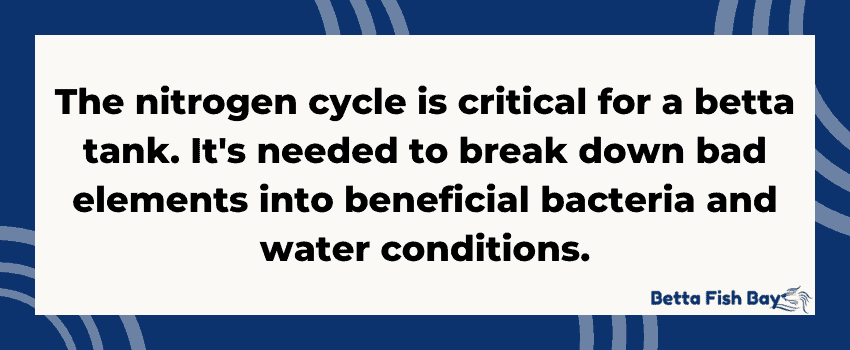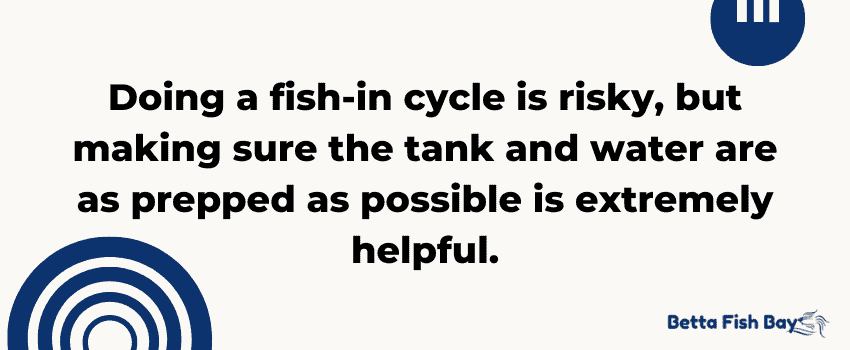Many new betta owners make the mistake of buying their betta before they have a cycled tank.
Experienced fish keepers may have a crashed nitrogen cycle in an established tank.
In both instances, you have no other choice than to perform a fish-in cycle.
I put together this guide on the fish-in cycle to help you avoid the common pitfalls you might encounter during this process.
A fish-in cycle can cause your betta stress and discomfort, so the main goal is keeping your fish safe.
But first, let’s talk about why the nitrogen cycle is so important for your betta’s ecosystem.

Table of Contents
Why Is the Nitrogen Cycle Important?

The nitrogen cycle uses beneficial bacteria to break down toxic ammonia and nitrite into less harmful nitrate.
Without an effective nitrogen cycle, your betta gets exposed to these toxins. Your betta fish may suffer from ammonia or nitrite poisoning.
Even trace amounts of ammonia or nitrite can cause health issues in bettas, such as:
- Breathing difficulties
- Ammonia burns
- Inflamed eyes and gills
- Loss of appetite
There is no instant cure for ammonia poisoning. But with supportive care, bettas can recover within a few days.
The cycling process is usually done several weeks before adding a fish to the tank. This is a fishless cycle.
Fish-in cycling is not ideal, which is why it is an emergency procedure. But with careful planning, your betta can survive a fish-in cycle with minimal discomfort.
Step-by-Step Instructions
1. Gather Your Supplies
Ensure you have everything you need before starting your fish-in cycle.
This includes having a complete tank setup with a heater and filter installed.
Live aquarium plants also contribute to the nitrogen cycle process. Plants filter ammonia and help oxygenate the water.
Other supplies you need for a fish-in cycle include:
- Clean bucket for water changes
- Gravel vacuum/siphon
- Water conditioner/dechlorinator
- Aquarium water testing kit
- Beneficial bacteria supplement
- Quarantine tank
You must use a water conditioner for every water change you perform during the fish-in cycle.
Water conditioners remove chlorine from tap water. Chlorine is not only harmful to your betta, but it also kills beneficial bacteria.
Some water conditioners, like this one, bind to ammonia and nitrite for up to 48 hours.
This binding process prevents these toxins from harming your betta while the beneficial bacteria do their job.
An aquarium water testing kit measures the pH, ammonia, nitrite, and nitrate levels in your tank water. Test tube kits are the best option because they are usually more accurate than test strips.
You may jumpstart the nitrogen cycle by adding a beneficial bacteria supplement. This speeds up the formation of beneficial bacteria colonies.
Choose a supplement with the Nitrospiros species of bacteria.
The substrate or filter cartridge from an already cycled tank also contains beneficial bacteria. If you choose this method, ensure the cycled tank is free from bacteria and parasites.
I also recommend having a quarantine tank on standby.
A quarantine tank gives your betta a safe place if something goes wrong during the fish-in cycle. It provides your betta with a safe recovery space in case of ammonia poisoning.
2. Prepare the Tank

Next, set up your betta tank with your preferred aquarium substrate, filter, and heater.
Ensure your tank is at least 5 gallons or larger. Anything smaller is unsuitable for a betta fish.
If you have live aquatic plants, place them in your betta tank. Your aquarium filter and live plants help remove harmful bacteria and control ammonia and nitrite levels.
Rinse tank decorations with hot water before placing them in your betta tank. This removes any dust or residue the decorations pick up from packaging or shipping.
Fill your tank with water and add a water conditioner. Follow the directions on the bottle for the correct dosage amount.
You may add a beneficial bacteria supplement to your betta tank, as well. This is optional, but it speeds up the formation of beneficial bacteria colonies.
Using substrate or filter media from an established tank is another method of increasing beneficial bacteria in your aquarium.
After filling your betta tank with water, ensure your filter and heater work as they should.
Your filter and heater play a crucial role in keeping your betta comfortable during the fish-in cycle.
Maintain a constant temperature between 78-80° degrees Fahrenheit (25.5-27° C).
Add your betta to the tank by using an acclimation process. Acclimating your betta lowers the risk of temperature shock.
3. Monitor the Water Parameters
Ideal Water Parameters for a Betta Fish Tank Include the following:
- Temperature: 78-80° degrees Fahrenheit (25.5-27° C)
- pH: 6.5-7.5
- Ammonia and Nitrite: 0 ppm
- Nitrate: < 40 ppm
- gH: 3-4 dGH (50-66.7 ppm)
- kH: 3-5 dKH (53.6-89.4 ppm)
- Minimum Tank Size: 5 Gallons
Test your tank water every day for ammonia levels.
In a fishless cycle, aquarists usually add an ammonia solution to their tank water.
Not only is this dangerous for your betta in a fish-in cycle, but it is also unnecessary. Fish waste from your betta releases ammonia for the beneficial bacteria.
When your ammonia readings start showing levels between 0.25 and 0.5 ppm (parts per million), you must do daily partial water changes.
Twice-daily testing is also needed at this point. Your goal is to keep the toxic ammonia levels lower than 0.25 ppm.
Start with 25% partial water changes. If ammonia levels rise to 0.5 ppm, perform a 50% partial water change.
Continue the process of twice-daily water testing and daily partial water changes.
Daily partial water changes are crucial at this point.
These water changes prolong the nitrogen cycle. But they help protect your betta from the harmful effects of toxic ammonia.
Ammonia levels above 0 ppm can harm your betta. Having ammonia levels of 0.25 ppm is not ideal for your fish, but is necessary in the early stages of the nitrogen cycle.
After several days, ammonia levels in the tank stop spiking and start tapering down. This signals the beginning of the nitrification process.
At this point, your water tests should show small amounts of nitrite.
4. Manage Ammonia and Nitrite Levels
Nitrite is more harmful to your betta than ammonia. This is because nitrite reduces the amount of oxygen in a betta’s bloodstream.
Even small amounts of nitrite can cause stress and discomfort for your betta.
You must keep nitrite levels as close to 0 ppm as possible for the health of your fish.
Continue with daily water testing and partial water changes. Partial water changes help you keep ammonia and nitrite levels low until the next step in the process.
Nitrite levels may spike for a week or two until they start trending downward.
Once nitrite levels start dropping, your tests may show traces of nitrate. This means the cycle is doing its job, but it is still not complete.
Nitrate is less harmful to bettas than ammonia or nitrite. Levels of nitrate less than 40 ppm are safe for your betta.
With daily partial water changes, it is unlikely for the amounts of nitrates to increase higher than 40 ppm.
Your live aquarium plants also help keep nitrate levels low by consuming them during photosynthesis. Beginner plants like Java Moss and Anubias are excellent at absorbing excess nutrients.
Keep testing your tank water and performing daily water changes. This prevents ammonia and nitrite from spiking and poisoning your betta.
You must remain patient throughout the nitrification process. The conversion of ammonia into nitrite and then nitrate may take several weeks.
This timeline depends on how much waste your betta produces and how often you do water changes.
Keep a close watch on your betta for signs of stress and illness. Your betta’s safety is crucial during a fish-in cycle.
5. Manage Your Betta’s Stress

During the fish-in cycle, you must manage your betta’s stress as much as possible.
Betta fish are sensitive to changes in their water parameters.
A fish-in cycle will cause discomfort and stress for your betta. There is no way of avoiding this, and it is why a fish-in cycle is only done in an emergency situation.
When a betta gets stressed, it suffers from a weakened immune system. This increases the risk of disease in your betta.
If you notice signs of distress or physical injury at any point in the fish-in cycle, remove your betta to a quarantine tank right away.
Some common signs of stress or injury due to a buildup of ammonia include:
- Lethargy
- Loss of appetite
- Lesions on the body or fins
- Fins with black edges
- Gasping for air
- Red/inflamed gills
- Clamped fins
Your betta may need antibiotic medication for severe injuries. This is why a quarantine tank is so important.
Using antibiotic medications in your main tank kills the beneficial bacteria. Your entire cycle crashes, and you must start over.
Maintain a regular feeding schedule for your betta during the fish-in cycle. Feed your betta two small meals per day at least 6-8 hours apart.
Avoid overfeeding your betta, and remove uneaten food after mealtime is over.
Overfeeding creates more fish waste, and leftover food rots on the substrate. Both of these substances can cause ammonia spikes as they decay.
Maintain stable tank temperatures so your betta is more comfortable during a fish-in cycle. Ideal temperatures for betta fish range from 78-80° degrees Fahrenheit (25.5-27° C).
These warm temperatures also encourage the formation of beneficial bacteria colonies.
Provide plenty of hiding places so your betta feels more secure and less stressed.
6. Check for Signs of a Fully Cycled Tank
After several weeks and many water changes, you’ve finally made it to the homestretch!
So, how do you know when you have a fully cycled tank?
Stable Water Parameters
The nitrogen cycle is complete when your water tests show 0 ppm of ammonia, 0 ppm of nitrite, and less than 40 ppm of nitrate.
These readings mean your beneficial bacteria are efficient in converting the ammonia and nitrite into nitrate.
Your betta is no longer in danger, and you only need partial water changes about once per week for maintenance.
With a regular cleaning schedule and good feeding habits, your water parameters should remain stable.
Minimal Algae Growth
Another sign of a cycled tank is minimal algae growth.
Algae feeds on various types of bacteria in an aquarium. These bacteria cannot thrive in the presence of ammonia.
In the early stages of the nitrogen cycle, algae cannot grow.
When the nitrogen cycle is almost complete, algae growth increases due to the higher levels of nitrate.
After nitrate levels decrease and become more stable, algae growth becomes limited.
Live plants reduce algae growth even further by consuming most of the nitrate in the water. Weekly water changes also reduce nitrate levels in your betta tank.
Crystal Clear Water
In the early stages of the nitrogen cycle, your betta tank may have a cloudy appearance. This cloudiness comes from bacteria floating in the water.
When the nitrogen cycle is complete, your tank water should look crystal clear.
Your Betta is Active and Healthy
After enduring the entire cycling process, you may notice changes in your betta’s appearance and behavior.
Without excess toxins in the water, your betta may appear brighter and become more active.
Maintaining a Healthy Environment for Your Betta Post-Cycle
Maintaining clean water is vital to your betta’s health and well-being.
Establishing a regular cleaning routine for your betta tank keeps your nitrogen cycle in check.
Perform a weekly water change and remove no more than 25% of the water from your betta tank. Taking too much water out can harm your colony of beneficial bacteria.
This can lead to ammonia and nitrite spikes when these helpful bacteria become imbalanced.
Dechlorinate the new water before adding it to your fish tank.
Clean the algae from the sides of your tank and use a gravel vacuum to remove fish waste and leftover food from the substrate.
Consider adding algae eaters like Amano shrimp and Nerite snails for efficient algae removal.
Remove dead plants and leftover fish food so they do not decay and release ammonia.
Always administer medications to your betta in a separate quarantine tank. Some medications can destroy your beneficial bacteria.
I recommend testing your aquarium water once a week. This helps you identify small changes in your water parameters before they become a much bigger problem.
Remember, Fish-In Cycles Are Only for Emergencies!
I cannot stress enough how difficult a fish-in cycle is for your betta.
Bettas are hardy fish, but they are not immune to the ill effects of toxins like ammonia and nitrite.
Keep your betta’s safety in mind during the entire cycling process.
Stay on top of testing your water parameters and performing water changes. This ensures a smoother process and an easier recovery for your betta at the end.


